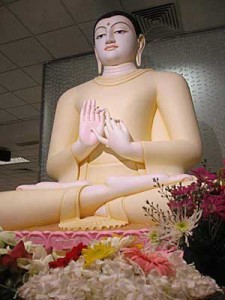Mind occupies the pre-eminent place in Buddhism, for everything that one says or does first arises in the mind as a thought. To have a well-trained mind is indeed to possess a treasure. When a person trains the mind, turns inward to examine and cleanse his own mind, he will find therein a vast storehouse of happiness. Real happiness is a quality of the mind which has to be sought and found in the mind.

The Buddha teaches that non-attachment to worldly pleasures is a greater happiness than the enjoyment of worldly pleasures. Nibbana is the highest happiness, the happiness of relief from suffering and from repeated birth, and this happiness is only to be attained by freeing the mind from its defilements.The misguided worldling thinks otherwise. In his view the enjoyment of sensual pleasures is the only real happiness. He forgets, however, that sensual happiness arises merely from the gratification of desire, and thus that this happiness must fade when the desired object is obtained. Nor will the multiplication of desires make sensual pleasure permanent, for there is no permanence in the passing. The pursuit of sensual pleasures ends only in restlessness and dissatisfaction.
The aim of Buddhist mental culture is to gain direct intuitive knowledge of the real nature of existence by systematic training of the mind through meditation. This practice issues in detachment and thus frees the mind from its delusions. Meditation leads the mind from the pain-laden things of the world to the sorrowless, transcendent state of deliverance, Nibbana. The basic cause of rebirth and suffering is ignorance of the true nature of life. We consider what is passing, unsatisfactory, and empty to be permanent, a source of true happiness, and substantial. This delusion sustains the craving for more existence and leads to the accumulation of kamma. Meditation is designed to lead step-by-step to the dissolution of these delusions and thereby to freedom from the grip of craving.
There are two kinds of meditation recognized in Buddhism: the development of tranquillity (samatha-bhavana), which emphasizes concentration, and the development of insight (vipassana-bhavana), which emphasizes wisdom. These two types of meditation respectively correspond to the second and third groups of the Noble Eightfold Path, the concentration group and the wisdom group. Concentration means one-pointedness of the mind, the ability to fix the mind on a single object to the exclusion of all else. Concentration is not an end in itself, but to be developed primarily because it is the basis for wisdom, the ability to see things exactly as they are. It is this wisdom that frees the mind from bondage.
To train the mind is not at all easy, for the mind has long been accustomed to flow in the channels of greed, hatred, and delusion; through ages we have relished sense pleasures, raged with anger, wallowed in torpor, fidgeted restlessly, and vacillated with doubt. Such habits are indeed difficult to break. Moreover, it is the very nature of the untrained mind to wander from one idea to another. Thus when the meditator sits down to begin the practice, strange thoughts may dance before his mind. To overcome these disturbances, the Buddha has taught five methods of expelling distracting thoughts:
Develop a good thought opposed to the distracting one; for example, develop a thought of loving-kindness to expel a thought of hatred.
Reflect on the evil consequences of distracting thoughts; for example, ill will or anger may lead to harsh words or an exchange of blows, to making enemies, or to something worse.
Turn the mind away from the disturbing thought and fix it on some beneficial idea or towards some useful activity.
Trace the cause of the uprisen evil thought and reflect on whether it will serve any useful purpose.
Struggle directly with the evil thought to crush it and subdue it.
At the outset meditation will be a continual effort to pull the mind back whenever it strays from the subject of meditation. It will seem impossible to focus the attention on the selected subject for more than a few seconds at a stretch. With continued practice, however, one will refine one’s skills until one can keep the mind focused steadily and calmly on the chosen topic for increasingly longer periods. Then the practice becomes more engaging, more rewarding, and also less tiring. Eventually one’s efforts will culminate in one-pointedness of mind, samadhi.
With the attainment of the one-pointed mind, the meditator turns this pure, steady, clear mind to the contemplation of existence itself. This marks the beginning of vipassana-bhavana, the meditative development of insight. The meditator mindfully investigates his own compound of the “five aggregates.” He sees that the body, or form, is made up of changing physical qualities, while mind itself consists of fleeting mental factors: feeling, perception, mental formations (intentions, emotions, thoughts, desires, etc.), and consciousness. He sees that these all occur in mutual dependence, all in a flow. There is no substantial self, no immortal soul within them to be called “I” or “mine.” As the impermanence, the unsatisfactoriness, and the selfless nature of the five aggregates become manifest to the meditator, he realizes that nothing conditioned is worth clinging to; for everything conditioned is fleeting, and in the fleeting it is impossible to find stable happiness. This is pañña, wisdom, the third and final stage in the Noble Eightfold Path.
With the development of wisdom, ignorance ceases in all its forms and shades. Craving and kamma, the fuel for the flame of becoming, is exhausted, and no more fresh fuel is supplied. Hence the flame of existence burns out for lack of fuel. When such a person who has reached the goal passes away, he no longer takes rebirth in any realm of becoming. He has attained Nibbana, the Deathless.
(This Article was taken by Sokia ky’s facebook wall)